National Museum of Denmark
The National Museum of Denmark (Nationalmuseet) in Copenhagen is Denmark’s largest museum of cultural history, comprising the histories of Danish and foreign cultures, alike. The museum's main building is located a short distance from Strøget at the center of Copenhagen. It contains exhibits from around the world, from Greenland to South America. Additionally, the museum sponsors SILA - The Greenland Research Center at the National Museum of Denmark to further archaeological and anthropological research in Greenland.[2]
Nationalmuseet | |
 | |
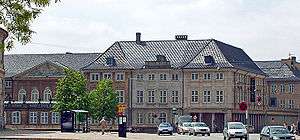 The Prince's Mansion in Copenhagen. Home of the National Museum of Denmark | |
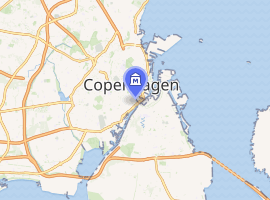
| |
| Former name | Det Kongelige Kunstkammer |
|---|---|
| Established | 1819 |
| Location | Ny Vestergade 10, Copenhagen, Denmark |
| Coordinates | 55.674722°N 12.574722°E |
| Type | National gallery |
| Visitors | 579.331 (2015)[1] |
| Founder | Christian Jürgensen Thomsen |
| Director | Rane Willerslev |
| Owner | State of Denmark |
| Website | Official Website |
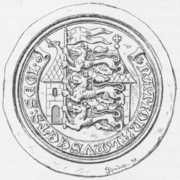
The museum has a number of national commitments, particularly within the following key areas: archaeology, ethnology, numismatics, ethnography, natural science, conservation, communication, building antiquarian activities in connection with the churches of Denmark, as well as the handling of the Danefæ (the National Treasures).
Exhibitions
The museum covers 14,000 years of Danish history, from the reindeer-hunters of the Ice Age, Vikings, and works of religious art from the Middle Ages, when the church was highly significant in Danish life. Danish coins from Viking times to the present and coins from ancient Rome and Greece, as well as examples of the coinage and currencies of other cultures, are exhibited also. The National Museum keeps Denmark’s largest and most varied collection of objects from the ancient cultures of Greece and Italy, the Near East and Egypt. For example, it holds a collection of objects that were retrieved during the Danish excavation of Tell Shemshara in Iraq in 1957.[3]
Exhibits are also shown on who the Danish people are and were, stories of everyday life and special occasions, stories of the Danish state and nation, but most of all stories of different people’s lives in Denmark from 1560 to 2000.
The Danish pre-history section was re-opened in May 2008 after years of renovating.
In 2013, a major exhibition on the Vikings was opened by Margrethe II of Denmark. It has toured to other museums, including the British Museum in London.[4]
Notable artifacts
- Golden horns of Gallehus (only copies are on display since the originals were stolen and melted down in 1802)
- Gundestrup cauldron
- Hjortspring boat
- Egtved Girl coffin
- Kingittorsuaq Runestone
- Snoldelev Stone
- Trundholm Sun Chariot
- Seikilos epitaph
- Holmegaard bow
- Tjele helmet fragment
Directors
- Christian Jürgensen Thomsen (1825–1865)
- Jens Jacob Asmussen Worsaae (1856–1874)
- Sophus Müller (1895–1921)
- Olaf Olsen (1981–1995)
- Steen Hvass (1996–2001)
- Carsten U. Larsen (2002–2008)
- Per Kristian Madsen (2008–2017)
- Rane Willerslev (2017–present)
Gallery
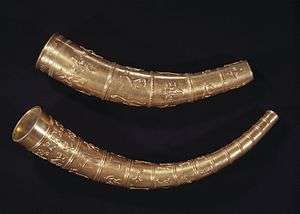 Copies of the two golden horns of Gallehus from around the 4th century
Copies of the two golden horns of Gallehus from around the 4th century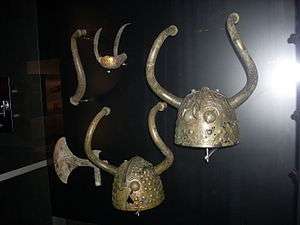 The Veksø helmets - bronze Age horned helmets from Brøns Mose at Veksø on Zealand, Denmark
The Veksø helmets - bronze Age horned helmets from Brøns Mose at Veksø on Zealand, Denmark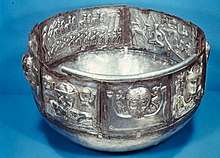 Gundestrupkarret (the Gundestrup cauldron), dating from the 1st century BC
Gundestrupkarret (the Gundestrup cauldron), dating from the 1st century BC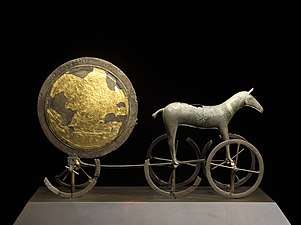 The Trundholm Sun Chariot, an important late Nordic Bronze Age artifact
The Trundholm Sun Chariot, an important late Nordic Bronze Age artifact.jpg) Nivisarsiaq, a painting of a Greenlandic girl who came to Denmark in the mid 18th century
Nivisarsiaq, a painting of a Greenlandic girl who came to Denmark in the mid 18th century The Egtved Girl coffin from the late Nordic Bronze Age
The Egtved Girl coffin from the late Nordic Bronze Age Exhibit of an aurochs skeleton
Exhibit of an aurochs skeleton Exhibit from the Danish 20th century section
Exhibit from the Danish 20th century section Exhibit from New Zealand. Showcasing sections of global history and traditions
Exhibit from New Zealand. Showcasing sections of global history and traditions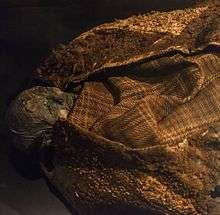
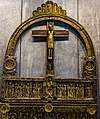 The golden altar of Lisbjerg Church built c. 1125-1150
The golden altar of Lisbjerg Church built c. 1125-1150
Publications (selected)
Nationalmuseets Arbejdsmark is the title of the museum's yearbook which has been published since 1928 and contains articles and other contributions.[5] ISSN 0084-9308
- Nationalmuseets Arbejdsmark 1807 - 2007. København: Nationalmuseet, 2007 ISBN 978-87-7602-079-8
See also
References
- "More Guests Than Ever at the National Museum" (in Danish). Archived from the original on 4 March 2016. Retrieved 1 March 2016.
- "About SILA". Archived from the original on January 14, 2009. Retrieved September 17, 2008.
- Mortensen, Peder (1970), Tell Shimshara. The Hassuna period, Historisk-Filosofiske Skrifter, 5, 2, Copenhagen: Kongelige Danske videnskabernes selskab, p. 14, OCLC 562453801
- Kennedy, Maev (19 June 2013). "Biggest Viking exhibition in 20 years opens – and this time they're angry". Guardian. London.
- Om Nationalmuseets Arbejdsmark; jelling.natmus.dk